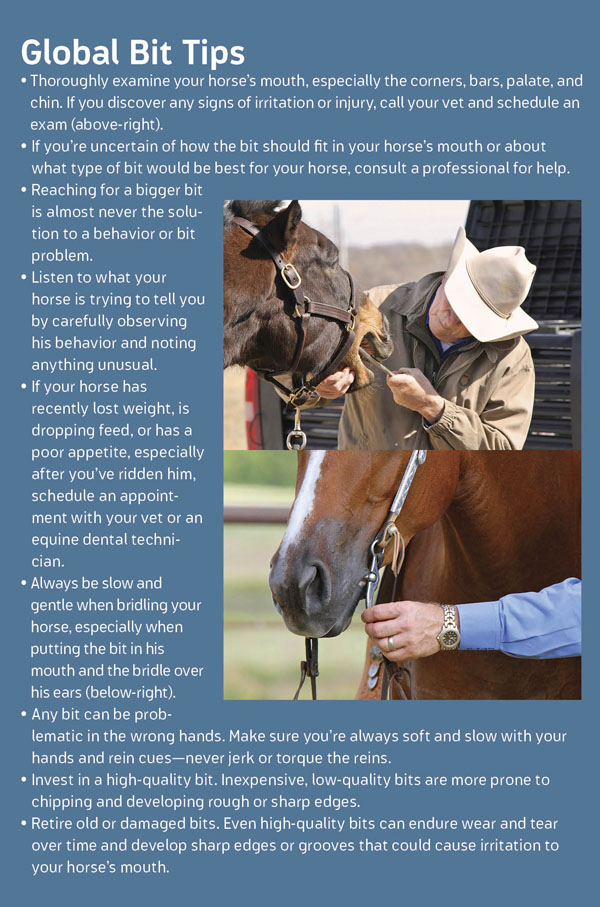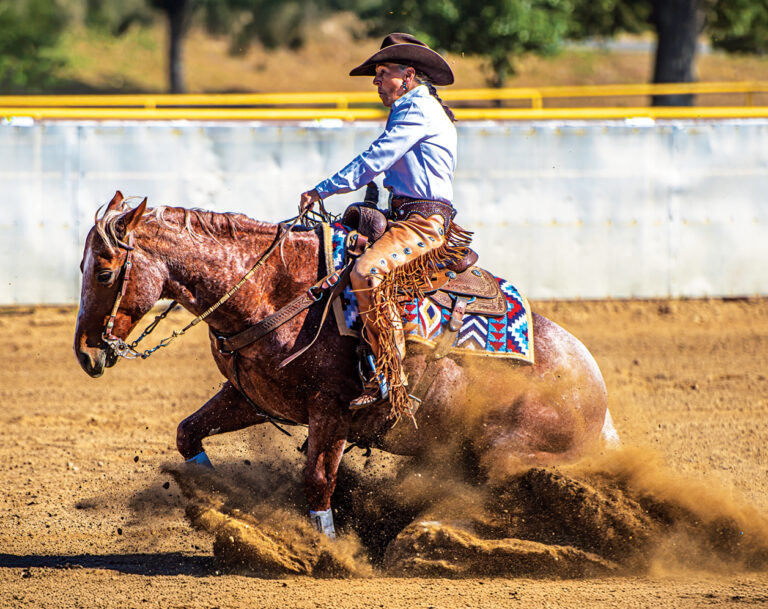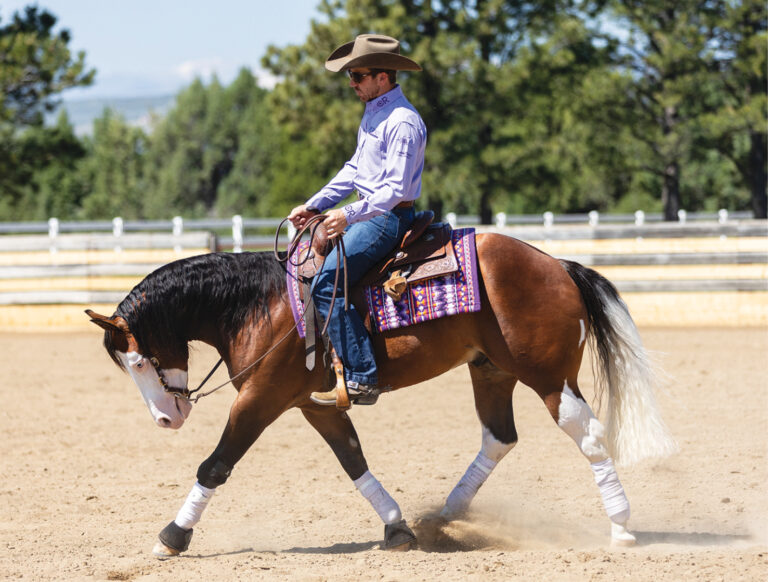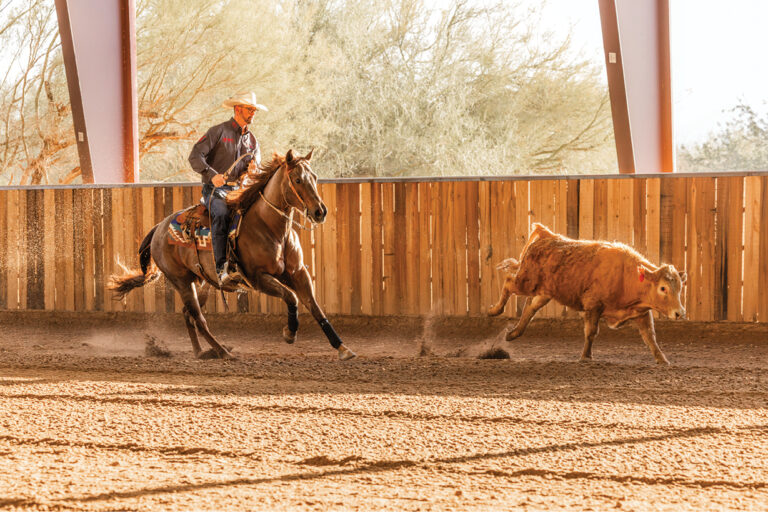If you’ve ever walked a mile wearing shoes that were too small or too big or just downright painful, you have an idea of how your horse feels in the “wrong” bit. And I’d bet that when you were walking in those shoes, you did your fair share of complaining—so you can understand why your horse might protest when trying to do his job in an ill-fitted or unsuitable bit.
[Disclaimer: Products we feature have been selected by our editorial staff. If you make a purchase using the links included, we may earn a commission. For more information click here.]

Finding the right bit for your horse is not only vital to his health and comfort, it’s essential for effective communication and to your overall success as a team—whether you’re in the show ring, on the trail, or are trying to accomplish a specific training goal in your backyard. Plus, you’ll find that the right bit makes for a happy horse, which, in turn, will increase his willingness and confidence.
Here, I’m going to address five signs that could indicate your horse isn’t a happy camper in his current bit. For each, I’ll explain the possible bit problem, offer a few solutions to consider, and provide insight on what else might be causing your horse’s behavior.
[Bits from Classic Equine Available on Amazon]
Sign #1: Head Tossing
Your horse throws his head up and down or from side to side at a standstill or when you cue him to move forward, backward, or turn.
Possible bit problem: The bit could be causing pain or irritation on the bars (the gum or inter-dental area between the front teeth and the molars) or on the corners of your horse’s mouth. And sometimes a bit can pinch or apply excess pressure to only one side of the mouth. If, for example, your horse tosses and pulls his head to the right when you take hold of the reins, he might be experiencing discomfort on his right bar. A bit that’s the wrong size or the wrong type for the shape of your horse’s mouth could be the cause of irritation on his bars or corners.
Considerations: Carefully examine the inside and outside of your horse’s mouth for any signs of bruising, redness, or sores. If you discover any indications that he’s in pain, stop riding and schedule an appointment with your vet to determine the best treatment and how much time off your horse may need. After your horse has recovered (or if there were no signs of injury to his mouth), focus on slowing and softening your hands and rein aids as you go about your regular riding routine before reaching for a different bit. If your horse continues to toss his head, consider trying a different bit, but keep in mind that going to a bigger or more severe bit is usually never the answer. In this case especially, a milder bit may prove helpful. If, for example, you’re using a solid bit, try a smooth-mouth snaffle—this bit could eliminate any excess pressure on the bars or corners of your horse’s mouth.
Possible other causes: A horse that’s especially stiff or resistant in his ribcage will sometimes toss his head in response to a rider’s leg pressure. If your horse seems to throw his head the moment you apply your leg, work on suppling him through his ribcage by asking him to bend his head and neck through circles and on straight lines to remind him that when you apply leg pressure, he should willingly respond and soften to you.
Sign #2: Bridle Evasion
Your horse avoids being bridled by lifting his head up, refusing to open his mouth for the bit, or backing away.
Possible bit problem: The bit may be exacerbating an existing dental problem. Points, sharp edges, and hooks develop on a horse’s teeth over time and can cause painful sores on the inside of his mouth, and a bit can further irritate these sores, especially if it’s too large or ill-configured for the shape of your horse’s mouth. Another possibility is that your bridle isn’t properly adjusted, which will prevent the bit from resting correctly in your horse’s mouth. If the cheek pieces are overly short, the bridle will pull the bit too tight in his mouth, which could cause pinching (and even tearing) at the corners or irritation on the palate. If the cheek pieces are too long, the bit will hang low in your horse’s mouth and could bump against his teeth; and if the cheek pieces are unevenly adjusted, the bit could rub or pinch any number of places in his mouth.
Considerations: Schedule a dental exam with your vet or a qualified dental technician to address any teeth issues your horse might have that could be interfering with the bit. Make sure your bridle is properly adjusted so the bit is resting in his mouth correctly. With a snaffle bit, you should see one wrinkle at the corners of your horse’s mouth; a leverage bit will hang slightly lower in the mouth than a snaffle, but not so low that it’s bumping against any of his teeth.
Possible other causes: If your horse is particularly irritable when you go to place the bridle over his ears, he could be suffering from ear mites, a tick or insect bite, or another condition on his ears. Bridle evasion can also be a learned behavior that your horse adopted over time due to a negative experience. For example, if you or another handler frequently jammed the bit in his mouth every time you went to bridle him, he might anticipate pain just at the sight of the bridle. And lastly, your horse may have learned that he can get out of work if you can’t get the bridle on him, especially if you’ve given up on occasion and put him back in his stall after an unsuccessful attempt.
[Tom Balding Bits Available on Amazon]
Sign #3: Chomping on the Bit
Your horse chomps or grinds on the bit while standing still, in motion, or both.
Possible bit problem: This behavior could indicate that the bit is too narrow for your horse’s level of sensitivity and therefore could be pinching on the corners of his mouth. Bit chomping can also be a sign that the bit doesn’t fit the inside of your horse’s mouth properly. Horses’ mouths vary in size and shape, so the same bit will fit a little differently in every horse’s mouth. For example, if a horse has a very thick tongue, the bit will naturally ride higher in his mouth and could apply unintended pressure to a horse’s palate. In my experience, however, horses that chomp on the bit are usually nervous or anxious about something.
Considerations: If you suspect your horse is anxious, try him in a bit with a roller in the mouthpiece. Nervous horses tend to “play” with the roller with their tongues, which often helps alleviate anxiety. Also, be sure to evaluate your body language. If you’re nervous in the saddle, your body is naturally going to be rigid and your cues may feel jerky or rushed, which could add to his anxiety. And, finally, consider any other reasons your horse might be nervous—is he in a new environment? Separated from a buddy horse? Does he become more anxious on the trail, away from the barn?
Possible other causes: Sometimes a horse may chomp on the bit out of boredom. If your horse is young or still a little immature, he may have a short attention span. In this case, a roller could also be helpful by giving him something to occupy his mind when he feels bored.
Sign #4: Braces Against the Bit
Your horse consistently feels heavy on his front end and braces against the bit at a jog or lope—or when you ask him to stop.

Possible bit problem: The bit may not be giving you enough leverage for your horse’s level of sensitivity. If your horse has any scarring on the bars of his mouth from previous damage, he may be numb or less sensitive to bit pressure.
Considerations: If you’re currently using a bit with a straight mouthpiece, try one with a low port. A port will encourage your horse to soften through his poll and lift his front end a little more. Many riders tend to go for more chinstrap (either a thicker, leather one or a chain strap) with horses that brace against the bit; avoid this, as a bigger chinstrap will only bring your horse’s head and front end down farther.
Possible other causes: If your horse is out of shape and lacks muscle in his back and hindquarters, he’s going to have a more difficult time engaging his hind end to lift his front end. In this case, you need to go back and work on some basic exercises to increase the muscling in his hindquarters. Other times, rider error can cause a horse to brace against the bit. A rider who is stiff in her hands and upper body, for example, will encourage her horse to break at the base of his neck, which in turn pulls his front end down. If you suspect you’re guilty of this, try lifting your hands a little higher to ask your horse to soften through the throatlatch and give in his face. And, lastly, some horses are built a little more downhill than others, meaning their hindquarters are more pronounced than their withers. This conformation can make it more challenging for a horse to lift through his front end, but strengthening and suppling his back end can help.
[Bits from Professional’s Choice Available on Amazon]
Sign #5: Poor Work Ethic
Your horse consistently has a bad attitude when it comes to work. He may pin his ears, wring his tail, or refuse to move off your leg pressure.
Possible bit problem: The bit may be the wrong size or type for your horse’s mouth, or it could have developed chips or sharp edges over time that are irritating your horse’s mouth. A high-quality bit will have a smooth finish on all joints and edges, and both sides of the bit will be identical in size, shape, and angle. Inexpensive bits are more prone to chips, sharp edges, and rough seams, and they’re often not made with the same high-quality alloys that give a good bit strength and resistance to corrosion. Another possibility is that your horse doesn’t like the taste of the bit, or he may not be producing enough saliva to feel comfortable in the bit.
Considerations: Carefully inspect your bit to check for any signs of chipping, grooves, or sharp edges that could be causing your horse pain. If you discover any significant flaws, throw away or permanently retire that bit and invest in a high-quality new one. If you suspect your horse doesn’t like the taste of his current bit, consider trying him in a mouthpiece made of sweet iron or copper. Many horses prefer the taste of sweet iron, and copper will encourage salivation.
Possible other causes: Your horse’s bad attitude could also be an indication that he’s experiencing pain in another part of his body. Poor saddle fit, for example, can quickly cause a horse to develop an aversion to work by making his back or withers sore. Or, he could have sore feet or hocks or splints—there are any number of physical problems that could be causing him pain. If you suspect this is the case, schedule a full exam with your vet.
Carol Metcalf, Pilot Point, Texas, has earned numerous AQHA world and reserve world titles in Western pleasure, Western riding, reining, and reined cow horse and was named the 2000 AQHA Horsewoman of the Year. She currently coaches youth and amateurs in reining and working cow horse, and owns and operates Metcalf Quarter Horses in Pilot Point, Texas, with her husband, Steven, and son, Carter.




